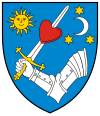Covasna
Kovászna | |
|---|---|
 | |
 Location in Covasna County | |
| Coordinates: 45°50′57″N 26°11′7″E / 45.84917°N 26.18528°E | |
| Country | Romania |
| County | Covasna |
| Government | |
| • Mayor (2020–2024) | József Gyerő[1] (UDMR) |
| Area | 155.11 km2 (59.89 sq mi) |
| Elevation | 560 m (1,840 ft) |
| Highest elevation | 600 m (2,000 ft) |
| Lowest elevation | 550 m (1,800 ft) |
| Population (2021-12-01)[2] | 9,208 |
| • Density | 59/km2 (150/sq mi) |
| Time zone | EET/EEST (UTC+2/+3) |
| Postal code | 525200 |
| Area code | (+40) 02 67 |
| Vehicle reg. | CV |
| Website | www |

Covasna (Romanian pronunciation: [koˈvasna] ⓘ, Hungarian: Kovászna, Hungarian pronunciation: [ˈkovaːsnɒ] ⓘ, German: Kowasna) is a town in Covasna County, Transylvania, Romania, at an altitude of 550–600 m (1,800–1,970 ft). It is known for its natural mineral waters and mofettas.
The town administers one village, Chiuruș (Hungarian: Csomakőrös). The village has a population of 451 and has an absolute Székely Hungarian majority.
Before Orbaiszék merged with Sepsiszék and Kézdiszék to create Háromszék County, in 1876, Covasna was the capital village of Orbaiszék.



